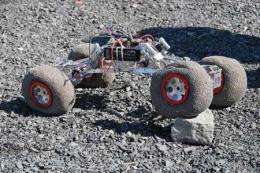8-inch iRings wheels demonstrating compliance using a rover testbed. / Photo: Brad Jones/Neptec Design Group
Creating a wheel for some of the worst potholes known to humankind is just one of the extraterrestrial challenges a team of McGill students and professors face in developing and testing a wheel prototype for the new Lunar Exploration Light Rover (LELR).
The new Canadian rover will be used during lunar exploration to carry payloads, cargo and crew, as well as enable drilling and excavation, manipulator and tool integration, and vision and state-of-the-art communications systems.
Mechanical Engineering Professor Peter Radziszewski is leading the team as part of an $11.5-million contract awarded by the Canadian Space Agency to Neptec Design Group.
“My students and I are thrilled to be on the Neptec Rover Team (NRT) as it will allow us to advance our earlier prototypes of lunar-friendly wheels and make a significant and innovative contribution to Canada’s space program,” said Radziszewski.
One of the issues with any wheel for an off-road application such as lunar mobility is shock absorption or shock damping. Typically, shocks in a vehicle are absorbed by the suspension system. However, if it is possible to dissipate some of the shock energy in the wheels themselves then it becomes possible to reduce the requirements for the suspension system. In this video, the test rover equipped with the first iRings prototype wheels is dropped to get an idea as to the shock damping characteristics. In this case, after falling about a couple of feet, the impact energy of the rover with the ground seems to be fully dissipated with the use of the iRings wheels.
Radziszewski and his team began working on developing wheel prototypes in 2009, one of which – dubbed iRing – is made of an external chainmail “fabric” filled with granular particulate matter; sort of like a metal bean-bag chair shaped like a wheel. This distinctive design provides both flexibility and sturdiness when travelling over extremely bumpy lunar terrain.
Radziszewski is quick to recognize the efforts of fellow colleagues and many McGill students – nearly 60 so far from both the undergraduate and graduate programs – who have been and will be involved on the wheel portion of this project and other aspects of the rover’s traction system development. “This effort is really a nexus of teaching and research. We have built a bank of expertise in creating intellectual property that supports a Canadian space-mobility effort,” he said.
The final prototype of the lunar rover is expected to roll out in the spring of 2012.
Provided by McGill University






















